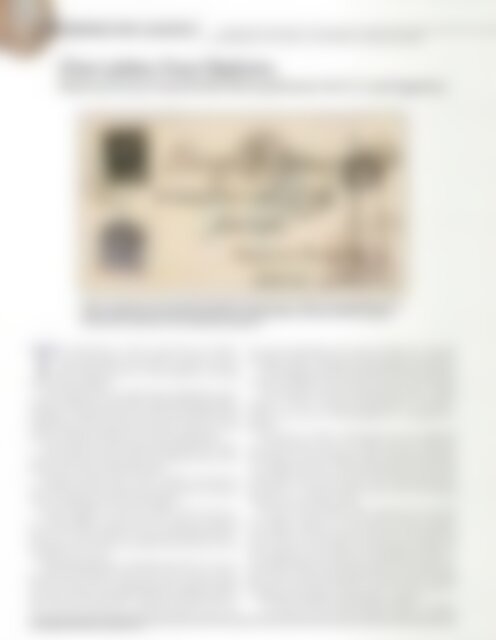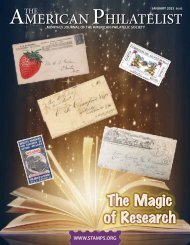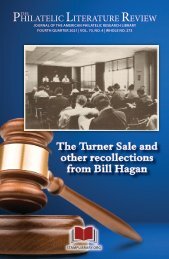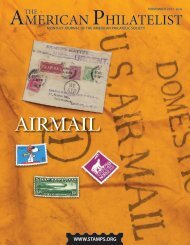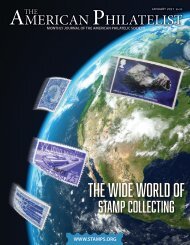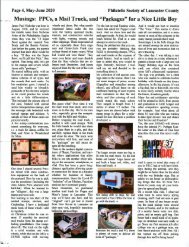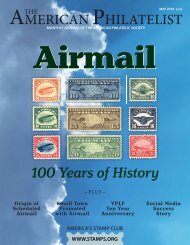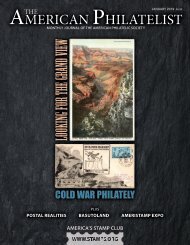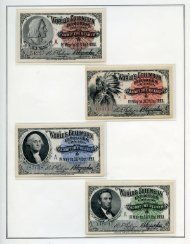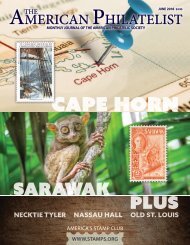August 2018 - Sneak Peek
The American Philatelist is the monthly journal of the American Philatelic Society, the world's largest organization for stamp collectors and enthusiasts. Members receive the printed magazine and can access the digital edition as a benefit of membership in the Society. Please enjoy this sneak peek. We're confident that once you see all that we offer, you'll want to join the APS today.
The American Philatelist is the monthly journal of the American Philatelic Society, the world's largest organization for stamp collectors and enthusiasts. Members receive the printed magazine and can access the digital edition as a benefit of membership in the Society. Please enjoy this sneak peek. We're confident that once you see all that we offer, you'll want to join the APS today.
Create successful ePaper yourself
Turn your PDF publications into a flip-book with our unique Google optimized e-Paper software.
CONCERNING THE CLASSICS<br />
C .........................................................................................<br />
BY DWAYNE O. LITTAUER - U.S. PHILATELIC CLASSICS SOCIETY<br />
One Letter, Four Nations<br />
Brazil and France Assisted Mail Moving Between the U.S. and Argentina<br />
Figure 1. A single rate cover from Boston to Rosario, Argentina July 21, 1869. It was prepaid 18 cents, 10<br />
cents per half ounce for the Brazil Line to Rio plus 7½ cents per quarter ounce for the French Ligne to<br />
Buenos Aires. It also shows 5 cents Argentine postage due.<br />
The United States, in 1867, entered into an arrangement<br />
with France that became an effective way to<br />
send mail between the U.S. and Argentina, with help<br />
from France and Brazil.<br />
From 1865 to 1875, the United States subsidized a steamship<br />
line called the United States and Brazil Mail Steamship<br />
Company, or the Brazil Line. It ran the nearly 6,000 nautical<br />
miles between New York and Rio de Janeiro. The rate to send<br />
a letter to Brazil by this line was 10 cents per half ounce.<br />
At the same time, France operated a steamship line (Ligne<br />
K) that ran between Rio de Janeiro and Buenos Aires, a distance<br />
of more than 1,300 nautical miles.<br />
Starting in <strong>August</strong> 1867, a letter could be carried from<br />
New York to Rio on the Brazil Line and from Rio to Buenos<br />
Aires or Montevideo on the French Ligne K.<br />
France charged 7½ cents per quarter ounce for its service.<br />
When added to the 10-cent U.S. charge, the combined<br />
rate was 17½ cents, of which 7½ cents was credited to France.<br />
Since there were no half-cent stamps at this time, the rate was<br />
rounded up to 18 cents.<br />
The rate progression is unusual because the U.S. rate was<br />
per half-ounce and the French rate was per quarter-ounce.<br />
Thus, the rate for a letter weighing between a quarter and half<br />
ounce was 25 cents, of which 15 cents was credited to France.<br />
The rate between half-ounce and three-quarters ounce was<br />
42½ cents (rounded up to 43 cents) of which 22½ cents was<br />
credited to France. Prepayment of the postage was required.<br />
George Hargest provided a detailed history of this service<br />
in the U.S. Philatelic Classics Society’s journal, The Chronicle.<br />
Our first three covers are from the same sender – lawyer<br />
George L. Winsor, in Boston, Massachusetts, to George L.<br />
Winsor, Esq., in care of Wheelwright & Co. of Rosario, Argentina.<br />
The first cover [Figure 1] illustrates an 18-cent single rate<br />
cover from Boston, on July 21, 1869 to Rosario. This is the<br />
first of three covers showing this route. The rate was paid by a<br />
3-cent 1869 issue and a 15-cent F grill of the 1867 issue. That<br />
covered the 10 cents per half-ounce rate by the Brazil Line to<br />
Rio and the 7½ cents per quarter-ounce rate for the French<br />
Ligne K service to Buenos Aires.<br />
The New York exchange office struck the red 7½ at the<br />
lower right to indicate 7½ cents credit to France. The letter<br />
was carried on the Brazil Line Merrimack, which left New<br />
York on July 23 and probably arrived at Rio on <strong>August</strong> 20.<br />
The octagonal French marking “ÉT-UNIS/PAQ. FR. K No. 1”<br />
was used for mail received from the Brazil Line, and the <strong>August</strong><br />
22 date in that marking likely indicates when the Ligne<br />
K steamer Aunis left Rio for Buenos Aires. The blue crayon “5<br />
¢” indicates the Argentine postage due in centavos.<br />
A second letter from Boston mailed October 21, 1868 to<br />
762 AMERICAN PHILATELIST / AUGUST <strong>2018</strong>


